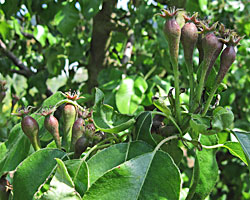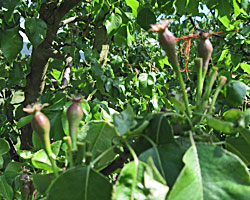We cannot overemphasize the importance of thinning the young fruit on your trees. Now is a good time to start thinning. Early thinning can help break the tendency of biennial (every other year) bearing that is common in some apple and pear varieties, and ensuring you have more even crops each year.
Some people are reluctant to thin, especially young trees- they are so anxious to get that fruit! But think of it like this: your tree has x amount of energy. If that energy goes into one thousand pieces of fruit, each little fruit gets 1/1000 of the potential growing energy there. But if instead that energy goes to 500 pieces of fruit, each fruit gets twice as much growing energy from the tree. By taking off half the little fruits, the remaining fruit can get bigger and be sweeter. Your trees can only produce so much quality fruit. If there is too much quantity of fruit, the quality will be less.
- Unthinned pears. Look at the size and quality of all the small pears in the cluster. Remove all but one or two of the nicest, unblemished, largest fruit.
- Same pear branch, after thinning.
Take the time to evaluate the growing small fruits in apple and pear clusters. Look for misshapen or blemished fruit, and remove that first. If you still have more than 2 fruits per cluster, choose the largest of the remaining fruit to leave.
On young or non-vigorous varieties, you can thin to one fruit per cluster. Always remove fruit at the end of the branches so it doesn’t bend the branch tips down.
Some years, stone fruits (plums, peaches, cherries) also set very large crops and will need thinning. It’s a good idea to thin these trees, too, to prevent branch breakage and increase the fruit quality. Removing fruit from the undersides of the branches is the easiest way to thin plums, and faster than thinning clusters.
Watching Heat Units
If you follow the blog post on tracking tools for orchard pests, you know that we watch heat units for codling moth and apple maggot spray timing. Right now, it looks like we’ll hit that critical number for codling moth (525 DD) around June 13 for Bellingham, and 3 or 4 days earlier inland. So if you plan to spray for codling moth, you should have your materials on hand early June.
For apple maggot, right now the models are showing a mid to late July fly emergence. If you’re using maggot barriers, get them on as you thin your fruit. For those of you who spray, hang sticky traps with an attractant by early to mid-June and monitor for adult flies. Be prepared to spray once you see 3-5 flies on the traps. If you’ve had light pressure in the past few years, hanging 3-4 traps in the tops of every tree can be an alternative to spraying.



